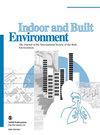Optimal ventilation strategy for multi-bed hospital inpatient wards: CFD simulations using a genetic algorithm
IF 2.9
3区 工程技术
Q2 CONSTRUCTION & BUILDING TECHNOLOGY
引用次数: 0
Abstract
Optimising ventilation strategy for an indoor environment necessitates systematically evaluating the influence of a diverse combination of physical and operational parameters in the design space. This study proposes a methodology that couples an evolutionary algorithm (genetic algorithm) with an evaluation mechanism (computational fluid dynamics) to determine the optimal ventilation strategy for an inpatient ward. The traditional approach would exhaustively simulate numerous scenarios to identify the optimal combination of parameters meeting the design objective. The proposed methodology would iteratively evaluate diverse design solutions with fewer CFD simulations than the traditional approach. The results of design space exploration suggest that design parameters, namely, location of the infected patient; air change rate; flow rate through local exhaust grille; and number, location and size of supply air diffuser and local air exhaust grille, are critical in minimising the risk of cross-infection caused through contact transmission in a ward.多床位医院住院病房的最佳通风策略:使用遗传算法的CFD模拟
优化室内环境的通风策略需要系统地评估设计空间中各种物理和操作参数组合的影响。本研究提出了一种结合进化算法(遗传算法)和评估机制(计算流体动力学)的方法,以确定住院病房的最佳通风策略。传统的方法将详尽地模拟许多场景,以确定满足设计目标的参数的最佳组合。与传统方法相比,所提出的方法可以迭代地评估不同的设计方案,并减少CFD模拟。设计空间探索结果表明,设计参数,即感染患者的位置;换气量;局部排气格栅流量;送风扩散器和局部排风格栅的数量、位置和大小,对于最大限度地减少病房内通过接触传播引起交叉感染的风险至关重要。
本文章由计算机程序翻译,如有差异,请以英文原文为准。
求助全文
约1分钟内获得全文
求助全文
来源期刊

Indoor and Built Environment
环境科学-工程:环境
CiteScore
6.40
自引率
25.00%
发文量
130
审稿时长
2.6 months
期刊介绍:
Indoor and Built Environment publishes reports on any topic pertaining to the quality of the indoor and built environment, and how these might effect the health, performance, efficiency and comfort of persons living or working there. Topics range from urban infrastructure, design of buildings, and materials used to laboratory studies including building airflow simulations and health effects. This journal is a member of the Committee on Publication Ethics (COPE).
 求助内容:
求助内容: 应助结果提醒方式:
应助结果提醒方式:


